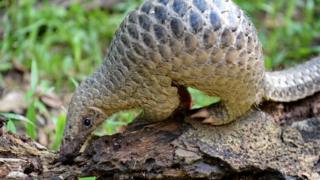Paving paradise to put up an eco-resort
Singaporeans are getting a new wildlife paradise to bring them closer to nature, but as the BBC’s Yvette Tan writes, the development is carving into the jungle and pushing rare animals into the path of danger.
It might be tiny, densely populated and commonly referred to as a concrete jungle, but Singapore has more wild space than most people realise.
Its 63 islands are home to hundreds of types of flora and fauna, including some of the most endangered species on the planet.
But these green spaces are shrinking fast amid rapid development.
One of the few places left relatively wild is the Mandai district in the north, where work is under way to create a sprawling eco-tourism hub, in which people can pay to experience nature close up.
The district is already home to the Singapore Zoo – considered one of the best in the world – a Night Safari and a River Safari.
By 2023, it’ll be joined by a relocated bird park, a rainforest-themed park and an eco-resort. At 126 hectares (311 acres) it will be the biggest eco-tourism spot in Singapore and a place to “celebrate and protect our biodiversity while being immersed in nature in a fun and inspiring way”, say the developers.
But in order to make way, two secondary forests are currently being cleared, threatening vital refuges for wildlife.
“There are mouse deer, pangolins, sambar deer, all of those animals live in the forests that are [being cleared],” Subaraj Rajathurai, who runs a wildlife consultancy, told the BBC.
As Mr Subaraj shows me around the Mandai development, it’s hard to imagine this land was once lush forest. Towering cranes and other construction equipment now stretch across the bare hills.
“It’s about a loss of habitat, loss of foraging area – a loss of food. So where do they go?”
The roads, it would seem, is where some of the animals are going.
Five animals – including a leopard cat, a huge sambar deer, a wild boar and a critically endangered sunda pangolin – have become roadkill since development began last January. All the accidents took place in the area around Mandai – with two occurring on a busy expressway.
According to Mr Subaraj, this is partly due to a lack of mitigation work by the developers, like insufficient fencing to stop animals running onto roads.
The land set aside for the new parks had been earmarked for development more than a decade ago. It once housed old villages and an orchid farm but after years of disuse, forests have reclaimed the area.
Mandai Park Development (MPD), the body behind the work, says developing the area into an eco-hub is a much more “environmentally sensitive” choice than if an urban development were to take over the area.
MPD is a branch of Mandai Park Holdings, a wholly owned subsidiary of Singapore’s state investor – Temasek Holdings.
It says not all roadkill incidents can be attributed to the development.
“Traffic incidents involving wild animals occur island-wide and are unfortunately, not a new phenomenon,” said Senior VP Philip Yim.
Mr Subaraj is not convinced.
“Take the case of sambar deer,” he says. They live all around the area known as the Central Catchment Nature Reserve “yet the only recent roadkills have occurred in the North”, he says, where Mandai is.
“Doesn’t that point to the development being the cause?”
MPD said it takes great care to ensure the safety of wildlife before it begins work in an area, including preserving trees of particular interest and moving wildlife.
It has put in places various safety measures such as speed humps, a rope bridge and wildlife crossing signs on Mandai Lake Road.
“There will inevitably be disruption… during the development phase, and this is actively being mitigated,” said Mr Yim.
He said MPD recognised that it had “a responsibility to try to reduce the likelihood of such incidents within the boundary of our project. We are closely monitoring incidents within and around the area”.
Mandai Lake Road, which cuts right in the middle of the upcoming Bird and Rainforest park, is the only road in, and out, of the eco-hub development.
There are also plans for a green bridge to be built specially for animals which will span the length of Mandai Lake Road and provide a safe passage for animals. That will be ready by 2019.
What does the future of the area look like?
The plan to build an eco-resort in the development that could hold up to 400 rooms, is another concern.
MPD has said the resort, to be run by resort operator Banyan Tree, will be built “sensitively… to reduce impact to the environment”.
But Mr Subaraj argues that this may not be enough.
“If you look in other countries, for example [at an eco-resort in] the Danum Valley in Malaysia, they’ve got around 30 rooms,” said Mr Subaraj.
“We’ve got up to 400 rooms. When you develop a resort that big, no matter how much mitigation you put in place, there will be an impact.”
The surrounding eco-system in the Mandai area, he says, will “never be the same again”.
“There are so little primary forests in Singapore that the animals have adapted to living in the secondary forests and relied on them to survive,” he said.
“If you look at our forests, there’s so little of it left. If you keep chipping away at it, one day there will be nothing left.”
Source: Read Full Article



